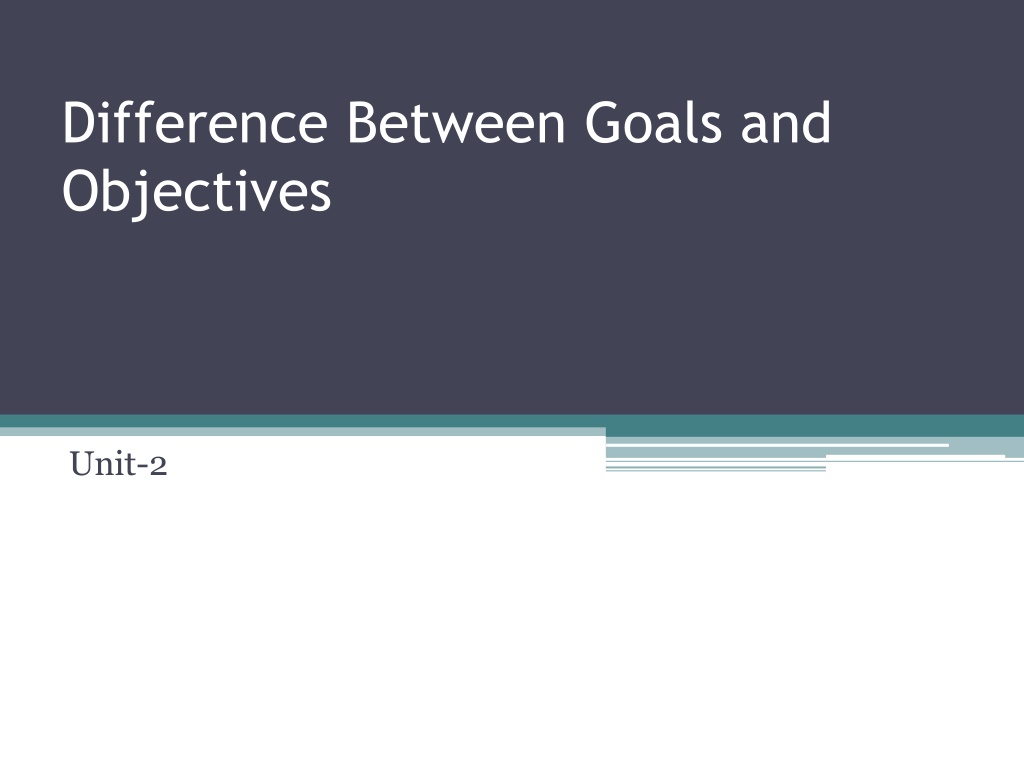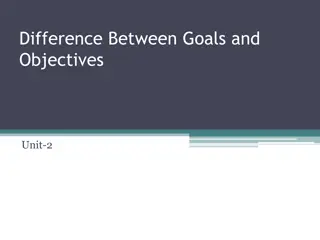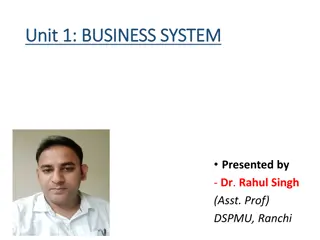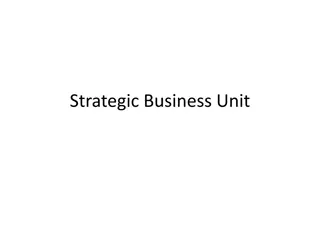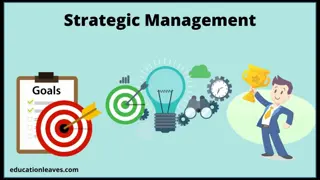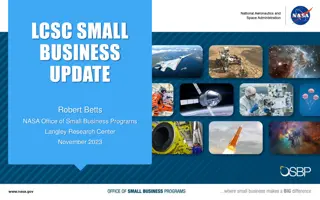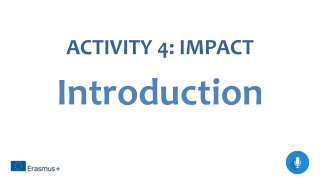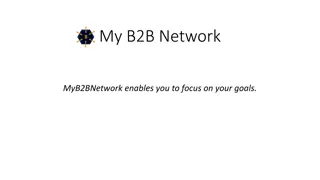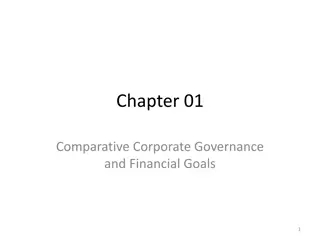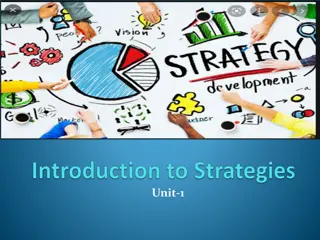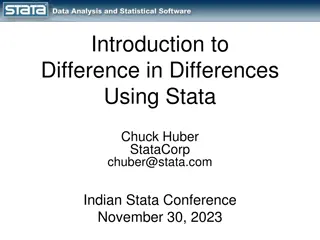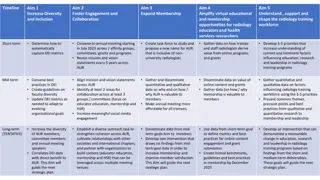Understanding the Difference Between Goals and Objectives in Business
Goals and objectives are fundamental aspects for measuring progress towards a company's vision. Goals represent lifelong aims, while objectives are specific, measurable milestones to be achieved within a limited time frame. Goals are broader intentions, whereas objectives are narrower and task-specific. This distinction is essential for effective strategic planning and goal achievement in organizations.
Download Presentation
Please find below an Image/Link to download the presentation.
The content on the website is provided AS IS for your information and personal use only. It may not be sold, licensed, or shared on other websites without obtaining consent from the author. Download presentation by click this link. If you encounter any issues during the download, it is possible that the publisher has removed the file from their server.
Presentation Transcript
Difference Between Goals and Objectives Unit-2
Goals and Objectives A company s goals and objectives are the foundation, which measures how much distance it has covered to attain its vision. Goals are defined as the lifelong aims, which an individual or entity endeavor to achieve something. It determines what the company is attempting to accomplish. On the other hand, objectives are the specific milestones which a person plans to achieve in a limited period. These are precise, measurable, time-based, actions that assist in the achievement of goal.
Goals and Objectives Every company sets out is goals and objectives, in order to reach its mission and vision. These are specific outcome which an enterprise aims to accomplish within the particular timeframe, that too with available resources. Take a read of the given article to understand the difference between goals and objectives.
Definition of Goals Goals are defined as the target or purpose that a person imagines or plans to accomplish or to reach or to achieve in future. They are the driving force that directs a person to make efforts to achieve it. In our childhood, we decide, what we want to become in the future and strives to achieve it. The goal is that point which a person envisions himself, after a particular span of time. To achieve these goals, people usually put a timeline, so that they can reach their goal in the desired time. However, they are long term.
Definition of Objectives The aim or target which you want to achieve within a limited period is known as the objective. They are the milestones that help you to reach your goal. That is why they are also termed as sub goals. It is a step to reach a particular point. Suppose I want to score 90% marks in an exam to get admission in a good university. Objectives are easily measured when the target is achieved. For example, A company wants to increase its sales by 50% in the upcoming six months and then when it hits the target it can be measured through the sales figure.
Key Differences Between Goals and Objectives The major differences between goals and objectives are provided below: Alignment and order: Goals are set to achieve the mission of an organization or individual, while objectives are set for the accomplishment of goals. Goals are thus higher in order than objectives. Scope: Goals are broad intentions and are often incapable of being measured in quantifiable units. Objectives are narrower than goals and are described in terms of specific tasks.
Key Differences Between Goals and Objectives Specificity: Goals are general statements of what is to be achieved. They do not specify the tasks that need to be performed to accomplish them. Objectives, on the other hand, are specific actions one takes within a certain timeframe. Tangibility: Goals can be intangible and non-measurable, but objectives are defined in terms of tangible targets. For example, the goal to provide excellent customer service is intangible, but the objective to reduce customer wait time to one minute is tangible and helps in achieving the main goal
Key Differences Between Goals and Objectives Timeframe: Goals are set to be achieved over a long period, while objectives are meant for a shorter time frame. A goal is usually divided into several objectives spread over multiple time frames. Language: The language used in describing goals is more focused on conceptual thinking, whereas that used in objectives is more on the creative side.
Benefits of setting workplace goals and objectives Although goals do not describe the method to achieve them, they set the direction for your efforts. In a business scenario, goals should be set to align with the mission and vision of the company. For individuals, workplace goals should align with their ultimate career aspirations. Benefits Goal & Objective are:- Goals give direction to your efforts. Goals are like a destination. Unless you know your destination, you do not know what direction to move toward. Goals help you set your priorities. While setting goals, you consider various accomplishments for your future and reflect on what achievements are more important to you. Once you have a clear idea about what is more important, and what is less important, it becomes easy to set your priorities. Then, you can focus all your efforts to achieve your goals and prevent yourself from wasting time on something that is not that important.
Benefits of setting workplace goals and objectives Goals increase your conviction in achievement. Defining your goals gives the conviction and confidence that the set goals are achievable. Successful people typically know where they are going and how long it would take them to reach their destination. Goals support decision making. When you have set goals, there is no confusion as to the direction you need to move toward. Whenever you need to choose between two courses of action, you can choose one that takes you toward your goals. As a result, having your goals defined aids effective decision making. Goals motivate you to act. Keeping your meaningful goals in mind motivates you to persevere. Instead of hoping to do something someday, you focus on your progress right away. The joy of achieving your goals motivates you to keep working, regardless of the difficulties involved.
Benefits of setting workplace goals and objectives Goals help you reach your full potential. Setting and working toward your goals can help you realize your full potential and capabilities. You might start believing in yourself more than ever before, making it easier and quicker to reach your defined goals than in a scenario with no goals defined.
Planning objectives for a business or individual offers the following major benefits: Objectives measure your progress. Objectives help in measuring progress made toward achieving large goals. If goals are not divided into objectives, they may seem unconquerable. Objectives offer a sense of achievement. Meeting objectives usually creates a sense of achievement and motivates you to work further toward reaching ultimate goals. Objectives confirm your confidence in the strategy. Defining your objectives gives you an opportunity to confirm that the overall goal strategy is formulated correctly and that you can be successful.
Planning objectives for a business or individual offers the following major benefits: Objectives help in making difficult decisions. If you are faced with a difficult situation and are unsure what to do, you can always refer to your objectives to make sure you are moving in the right direction. Objectives help you understand what your company expects from you. Managers can use objectives to set targets for their team and motivate them to work toward a common goal.
Tips for formulating effective objectives Keep the following points in mind to help you plan effective objectives: Assign measurable targets Set up different objectives for different markets so you can establish desired outcomes for different users and geographical areas. Before finalizing an objective, refine it through multiple rounds of input, feedback and analysis. Consider the trade- offs between different factors (for example, giving up on some amount of efficiency in exchange for better customer service).
Tips for formulating effective objectives Describe the desired outcome rather than the actions required to attain that outcome. Relate your objectives directly to the overall goals of the company. Involve people responsible for attaining the objectives in the formulation process. Make sure your objectives are specific, measurable, achievable, realistic and time-bound.
Strategic Intent Meaning Strategic intent refers to the pre-defined future state that the organization is planning to reach within a stipulated period of time. The term strategic intent was popularized by Gary Hamel and C.K Prahalad. They defined strategic intent as the reason of existence of an organization and the ends it wants to achieve. It shows the beliefs and values of an organization. To achieve a certain future state and to achieve certain ends the organization should take certain courses of action. These ends can be either long-term or short-term. While the long-term ends have broad focus, the short-term ends are narrow in nature. For an organization to become effective, it is very important for every staff member to have an understanding of the strategic intent. Hence, the strategic intent should be achievable as well as understandable.
Attributes of Strategic Intent Strategic intent defines the nature of the path which an organisation needs to follow in order to secure the long-term strategic position that is to be achieved (accomplished) by the organisation. According to Hamel and Prahalad, if the organisation clearly communicates its strategic intent, then each activity would have precise and consistent purpose. Strategic intent has the following attributes :
Attributes of Strategic Intent 1) Sense of Direction : The sense of direction defines where the organization wants to go in the future and why. Every organization requires a significant, steady, and common end. These ends should be valuable and necessary for the organization. The environment and market for business changes very frequently and hence the strategic decisions should not be based on these short- term motives, else the efforts made by the organizations become inconsistent and fail to achieve the desired future state. Therefore, the organizations should pursue a long-term mutual end, which is consistent and shared in nature. A proper set direction helps organization to achieve its long- term strategic intent.
Attributes of Strategic Intent 2) Sense of Discovery : The sense of discovery refers to the ability of inspiring the employees for innovation and creativity. This is necessary because the employees feel less enthusiastic when the strategic intent is not inspiring. The strategic intent should motivate the employees to perform the challenging tasks and explore new concepts. It should introduce new dimensions in the organisation and innovate superior ways to achieve them.
Attributes of Strategic Intent 3) Sense of Destiny : The sense of density refers to the ability of the strategic intent to provide meaning to the existence of the organisation. It should be able to create a sense of respect among the organisational members. Strategic intent should be meaningful and significant so that it can direct the organisation and motivate its employees. Thus, strategic intent must be meaningful for the employees and have the capability to set proper direction for them.
Hierarchy of Strategic Intent A) Vision : Hierarchy of strategic intent vision is a mental perception of the kind of environment and individual or an organization aspires create within a board time horizon and the underlying conditions for the actualization of this perception. Vision statement can be referred as the statement defining company's long term goals. A vision statement can exceed from one line to a few paragraphs highlighting what the organization want to achieve in future. An effective vision statement motivate the employees and provide them a sense of direction for carrying out day to day business activities and also help in taking strategic decisions. A vision statement is prepared to boost the moral of the employees by painting a picture of the path on which the organization is heading. The vision statement of an organization allow the managers to practically monitor the organizations progress by comparing the stated objectives and operational plans for achieving those objectives.
Hierarchy of Strategic Intent FEATURES OF A GOOD VISION : Should be realistic and idealistic. Clarifies direction for the organization. Inspires organization members and encourages commitment. Reflects the uniqueness of the organization, its distinctive competence. Appropriate for the organization, consistent with its values and culture. Well articulated and easily understood.
Hierarchy of Strategic Intent B) Mission : A mission provides the basis of our awareness of a sense of purpose, the competitive environment degree to which the firms mission hit its capabilities and the opportunity which the government offers. Mission defined as the fundamental, unique purpose that sets a business apart from other firms of its type and identifies the scope of its operations in product and market terms. It is a statement of attitude, outlook and orientation. It communicates what the firm wants to be. It indicates the businesses the firm will pursue and the customer needs it will seek to satisfy. Shaped by the vision of the corporation's leaders.
Hierarchy of Strategic Intent NEED FOR A MISSION To ensure unanimity of purpose within the organization. To provide a basis for motivation. To establish an organization climate. To serve as a focal point. To facilitate the translation of objectives and goals into work structure. It implies the image which the firm seeks to project.
Hierarchy of Strategic Intent C) Business Definition : Business definition refers to the description of products, services, activities, functions, and markets in which an organization deals. It is a component of mission statement which forms the foundation for all the strategic planning processes and shows the organization a way to achieve success. It also helps the organization in estimating the changes as well as their effects. Business definition outlines the current position and the desired future positions. It discusses the operations of the business but does not exactly specify the reasons behind particular operation.
Hierarchy of Strategic Intent Some of the questions that are needed to answer while defining a business are : What are the products, services, or markets in which the organisation operates? Who are the target customers? Which activities and functions are performed to satisfy the customers? What are the resources and capabilities utilised to satisfy the customers?
Hierarchy of Strategic Intent D) Goals : Organisational goals refer to the ideal situations to be achieved in undefined time-duration in future. These goals direct the daily activities and decisions. However, goals do not essentially lead to the quantifiable outcomes. These statements are related to the vision and mission statements. Goals can be followed for day-to-day operational activities and decisions, not essentially tied up with quantifiable results. Organisational goals provide the standards to measure the performances for achieving the wide-ranging objectives. These are the targets that convert the vision and mission into reality. Goals help in portraying a positive image of the organisation in the industry. It plays an important role in maintaining public relations and encourages support from various groups.
Hierarchy of Strategic Intent Features of Goals : 1) Specific : The goals should clearly specify targets to be achieved and the tasks to be fulfilled. This would help the managers in evaluating the performance at regular intervals. An ideal goal should address major issues that are critical for success of the organization. . 2) Realistic and Challenging : An organizational goal should be realistic as well as challenging. If the goal is unrealistic, the employees may find it unachievable and may get de-motivated . But, the goal should also not be too easy. It should be challenging enough so that it can encourage the employees to improve their performances by searching new and creative ways of carrying-out the organizational activities. 3) Time Constraint : Another important characteristic of an organizational goal is that there should be a time-period associated within which it has to be completed. It provides a deadline to the employees and managers so that they are motivated to improve performance for achieving success within the time constraint.
Hierarchy of Strategic Intent Features of Goals : 4) Measurable : The goals should be quantifiable. It implies that the goals should be measurable so that the outcome could be evaluated and the progress can be estimated. Measurable goals act as a yardstick for the managers and their team members to evaluate their performance. . 5) Level-Oriented Goals : A goal should be set to address important issues only. The top and middle level managers are accountable for such long-term goals. On the other hand, the short-term goals should be addressed by lower-level managers. 6) Commitment : The members of the organisation should be committed for the achievement of set goals.
Hierarchy of Strategic Intent Types of Goals : 1) Official Goals : Official goals are the common objectives of the organization. These goals validate the activities of the organization and stabilize the organization in its environment. These goals are mentioned in the documents published in the organization periodically, such memorandum of association, annual performance report, etc. The top level management addresses these goals in their public statement. 2) Operative Goals : Operative goals indicate the actual targets that an organization wishes to achieve. These can be considered as the operating policies. These goals help the managers in reducing the possibilities of uncertainty while remaining attentive. The operating goals help in selecting the alternative designs for organization. 3) Operational Goals : These goals are set by the middle level managers for supervising or controlling the subordinates. These goals help in measuring the performance of the employees.
Hierarchy of Strategic Intent E) Objectives : Objectives are states or outcomes of behavior that are desired. An organisation may desire either to obtain something that it does not currently have or to retain something it already has. Hence, objectives may be either acquisitive or retentive. Strategic objectives are those aims that are formulated to bring major changes in response to the changes, competition, and issues in the environment. These objectives are formulated to address various internal and external issues such as target customers, target markets, product, and changes in technology, etc.
Core Competencies of a business Every business has its own core competencies, some of the common core competencies for the business would be:-
